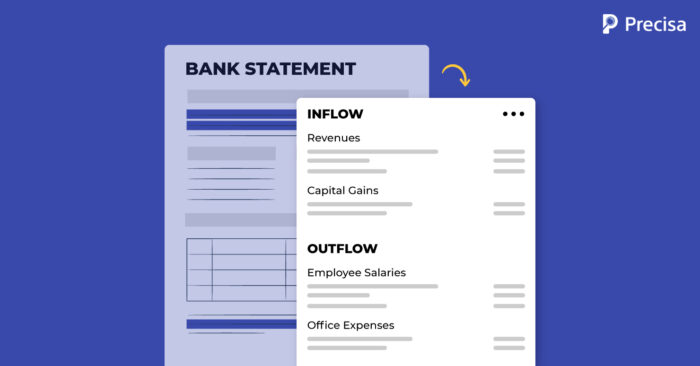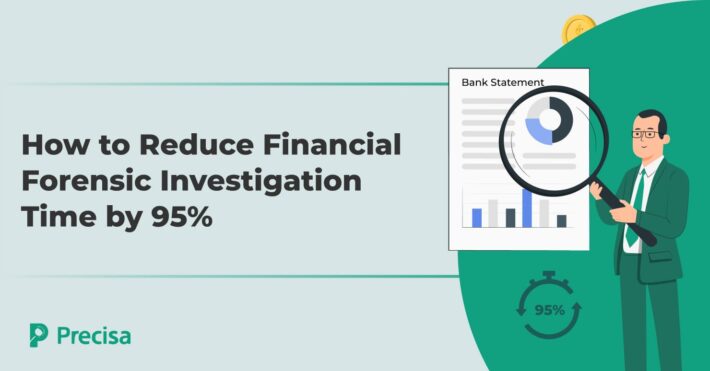Everything You Need to Know About Bank Statement Extraction As a Lender

Digital transformation in India has paved the way for accelerated growth in the lending domain.
According to reports, the lending market size was valued at $ 270 billion in 2022. This figure is projected to grow at a compound annual growth rate of 22% to over $ 720 billion in 2030. A mix of banks, Non-Banking Financial Companies (NBFCs), and digital lending platforms are vying for market space.
In such a competitive landscape, lenders must facilitate quick turnarounds on loan approvals without compromising the risk assessment process.
Slow processes can fail to convert leads, while inaccurate risk assessment can lead to revenue loss and potential for growth of NPAs (Non-Performing Assets) and cases of loan fraud.
This is where automated bank statement extraction software can bring efficiency and accuracy to the risk assessment process.
In this blog, let’s understand the basics of bank statement extraction and how the use of AI-powered technology can help lenders reach their full potential.
Bank Statement Vs Bank Statement Extraction
A bank statement refers to a systematic listing by date, time, transaction details, and value of all financial transactions carried out by the account owner during a specific time frame.
Account owners usually receive a bank statement every month. When a borrower applies for a loan, lenders review bank statements in great detail to assess the financial habits and cash flows of the borrowers as part of the underwriting process.
Bank statement extraction, on the other hand, is the physical extraction of transaction data into a more consumable format that enables lenders to analyse the data quickly and in-depth. Data entry operators can do the extraction manually, which is time-consuming, error-prone, and costly.
Alternatively, it can be completely automated by bank statement extraction software.
What Is Bank Statement Extraction Software?
Bank statements play an important role in helping lenders make key decisions in the underwriting process. Transactional data in bank statements allows lenders to review borrowers’ finances and make accurate decisions.
However, it is challenging for lenders to manually analyse the data in its existing format because it appears as a series of generic transactions.
This is where bank statement extraction software adds excellent value. This solution automates the extraction of transactional data into over 20 to 30 inflow and outflow categories, simplifying lenders’ financial analysis process.
- Examples of inflow categories include revenues, capital gains, bank interest, and tax refunds.
- Outflow categories are employee salaries, vendor payments, office expenses, penalties, fees and charges, and taxes.
A superior cloud-based, AI-powered bank statement extraction tool like Precisa can extract data from over 700 file formats within minutes, followed by a thorough analysis of the information.
Benefits of Automated Bank Statement Extraction for Lenders
Here’s a brief overview of how automated bank statement extraction solutions are advantageous for lenders.
1. Higher Efficiency
Bank statement extraction software automates the entire data categorisation process. The use of superior technology helps reduce errors, omissions, and duplication of data during processing.
This increases efficiency while reducing the time and labour required to accomplish this important step in the underwriting process.
2. Comprehensive Risk Assessment
Only once all bank transaction data is accurately categorised into the right sub-categories can there be a proper analysis of financial data. A superior tool follows up the extraction process with an in-depth financial analysis of all data to paint a 360° picture of a borrower’s financial status.
For instance, lenders can get an accurate idea of a borrower’s cash balance, cash flows, deposits, withdrawal history, cases of bounced cheques, loan repayment defaults, and frequency of cash overdrafts.
Lenders can benefit from a detailed report accompanied by a creditworthiness score based on all transactional data.
3. Data Security
Security is a major concern for lenders because so much of a customer’s sensitive financial data is at stake. Data breaches can compromise the confidentiality of consumer data, as well as the credibility of lenders.
A superior bank statement extraction tool prioritises data security and ensures that data is stored and organised securely and remains confidential.
4. Quicker Turnaround on Loan Applications
With banks, NBFCs, digital lending platforms, and payment apps all vying for similar target audiences, lenders need to respond to loan applications quickly and effectively to stay competitive.
The use of automated extraction and analysis tools gives lenders an edge by expediting the underwriting process and turning leads into customers with a longer customer lifetime value.
5. Data-Driven Loan Personalisation
Loan products must be relevant to borrowers who have a diverse set of needs. However, the traditional lending approach offers standardised products that can prove to be expensive, especially for Micro, Small, and Medium-sized enterprises (MSMEs).
Accurate bank statement extraction software, however, changes the game for lenders and their MSME customers. This tool offers in-depth data insights that inform lenders of a borrower’s real-time needs, enabling them to offer cost-effective, customised solutions.
6. Potential to Scale Faster
Cloud-based bank statement extraction tools can process large volumes of bank statements of multiple borrowers simultaneously and efficiently.
Thus, lenders aiming to accelerate growth can reap the benefits of automation to scale quickly.
7. Make Data-Driven Decisions
With efficient data processing at the centre of bank statement extraction, lenders can access large volumes of consumer data. AI-powered software enables them to predict future consumer behaviours and shape businesses and lending strategies based on real-time, predictive data.
8. Higher Operational ROI
Lenders can cut costs by streamlining the lending workflow and running operations with lean business teams. By offering relevant products to a wider range of customers, they can be inclusive and drive revenues.
Superior risk management ensures that more borrowers repay their loans, thus boosting profitability.
The Takeaway
Leveraging automated bank statement extraction software helps lending teams get an accurate and efficient risk assessment and underwriting results. They can also deliver more value to borrowers through relevant, cost-effective loan products.
Presica’s comprehensive and seamless financial data analysis solution simplifies and speeds up the process through automation. The software provides actionable insights on a customisable dashboard, thus helping companies make informed business decisions.
Request a free demo today!




